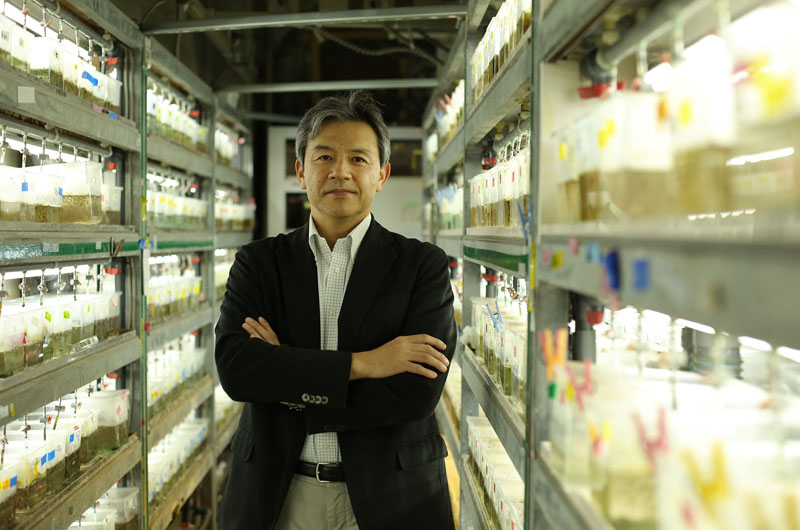Interviewer: I have just had a look at the room in which the medaka fish (Japanese killifish) are kept. There are a tremendous number of fish in the tank aren't there? The temperature and the humidity were so high, it was like I had been transported to the tropics.
Takeda: We maintain the temperature constantly at around 28 degrees Celsius. It's like a mini aquarium don't you think?
Interviewer: That was the impression I got. Your laboratory is divided into rooms for housing animals, an experimental lab and a classroom. How many people are there in your laboratory?
Takeda: There are 19 students, two technical assistants, two assistant professors and one associate professor, in addition to myself.
The uniform flow of time through a laboratory
Interviewer: So are all 25 of you engaged in research using the medaka fish and zebrafish on a daily basis?
Takeda: A great deal of the work we do involves fish eggs. Every morning at around 9:30am we collect eggs from the medaka fish and zebrafish. Fertilized eggs immediately begin to develop and so the day usually starts with various operations relating to the eggs. The students and professors are busy doing this throughout the morning. There are times when egg collection will continue through to the afternoon, but generally the afternoons are spent doing experiments in the lab. That is how time passes in a research laboratory. One of the things that happen regularly is a monthly meeting in which students report on what they have been doing in the lab. The 19 students are split into three groups, so approximately every ten days we hear research reports from groups of students. Each week we also hold a seminar in which the work of other research groups is introduced…. This is the way we spend our days and as experimental data builds up we will move to the stage where the students set about writing research papers. I provide individual supervision and guidance to each student and we work on the papers together, most of which are written in English. The students first write their papers, after which I take a look at them and add comments, meaning that through to completion the writing process takes at least two or three months. There are times when additional experiments need to be implemented, so sometimes it can take around six months for a paper to reach completion.
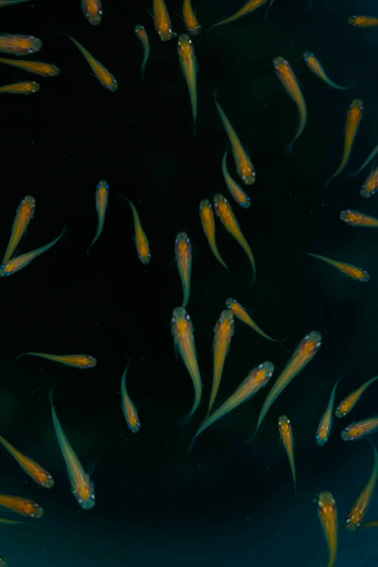
Photo: Jun'ichi Kaizuka.
Interviewer: So you are providing individual supervision and guidance to students?
Takeda: Yes, and it consumes quite a lot of time. Once a paper is completed it is then submitted for publication to an academic journal such as Nature or Cell, but whether the paper will be accepted and when it will actually be published is very much on a case-by-case basis. If everything runs smoothly it generally takes about two months for a paper to be accepted, but if there are requests for further experiments or other changes, the entire process can take up to a year. I think that for the students the process of compiling and submitting papers is a learning experience above and beyond the performing of actual experiments. For a researcher it is very important to be able to express the results gained from experiments and present them to the outside world. There are many manuals available that detail experiment methods and procedures, and students are also able to learn directly from their seniors. However, learning from your supervisor while actually writing a paper is a valuable experience that will be useful in the future for budding researchers. Students on the Master's program are generally only able to write their Master's thesis, but for students on the doctoral program, over the course of five years they produce between one and five papers, on the basis of which they are granted their doctoral degrees.
Interviewer: On average how many research papers are produced by your laboratory each year?
Takeda: In a good year, approximately five papers are published, although sometimes when the submitted papers do not pass the review process, there may be only one paper published during the course of a year. So in general you could say between one and five papers a year. Each of the students is in a slightly different phase of their research so the timing of the paper compilation process also varies. The professor provides guidance and supervision to all the students. In terms of "education" this is one of the most important jobs a professor can do. At the same time however, the professor must also engage him or herself in efforts to attain scientific research grants in order to maintain and develop the activities of the laboratory.
Interviewer: The application process for scientific research grants appears to be very tough.
Takeda: It is. One of a professor's major tasks is to write applications and compile reports seeking funding in the form of grants. The busiest times are from December to February, which is when students are graded, and then in September and October, which is the peak time for applications for research grants. Outside those peak periods time goes by in the daily routine of providing thesis supervisions to students and writing research grant applications to various foundations and organizations. When I think about my own work, outside of the activities of the laboratory, there is also a good deal of management work to be done too. Until two years ago I worked as the head of the Public Relations Office in University Central Administration, and now I am serving as the vice dean of the Graduate School of Science. In addition, I travel overseas five or six times a year to attend academic conferences, symposia and lectures around the world.
Interviewer: You have a very hectic schedule. I get the impression that as you go about your various duties and activities your laboratory continues to engage in various experiments and to produce academic papers.
Takeda: That is true. Occasionally, from among the papers produced there are one or two that could be termed hits, or "home-runs." However, due to my busy schedule I scarcely have any time to write papers of my own. This is one of my constant concerns.
Interviewer: How many years has your laboratory been operating at Todai?
Takeda: I was previously engaged in research at the National Institute of Genetics in Mishima City, Shizuoka Prefecture. I transferred to Todai in 2000, so I have been here 13 years this year. Over the course of 13 years my laboratory has produced approximately 40 papers in total. The pace at which papers are published varies depending on the area of specialty-there are some areas where it is possible to write many papers, and others where the creation of a research narrative requires more time and is therefore not suited to frequent publication. My area of research falls into the latter category. However, what remains unchanging, regardless of my own hectic schedule and the busy world around us, is that time flows uniformly and in this way we continue to build up research results.
The sophisticated mechanism known as the segmentation clock
Interviewer: I would like to ask a little about the relationship between your specialty, embryology, and "time." I have heard that the fertilized eggs of small fish start to develop almost before your very eyes, within the space of 30 minutes after fertilization. This is a real example of "condensed time," isn't it?
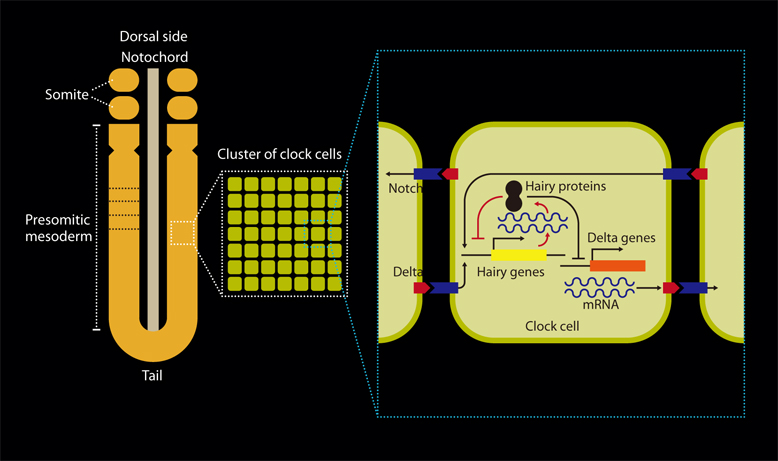
Segmentation clock. The mesoderm extends round both sides of the neural tube, forming a U-shape around the tail. The presomitic mesoderm, which is a collection of cells prior to formation into a body segment (somite), is a cluster of clock cells that behave autonomously.
The transcription of the hairy gene starts with the activation of the notch receptor. This process of transcription and translation continues until hairy proteins (transcription factors) reach a certain concentration, after which gene transcription is suppressed (this process is known as "negative feedback"). As the hairy proteins degrade easily they disappear after a certain time. However, if the notch receptors are stimulated, the transcription of hairy genes begins once more. At the same time clock cells create delta proteins (These are activated by coupling with notch receptors on the surface of adjacent cells). The hairy proteins work to suppress the transcription of delta genes. By conceiving a model for the intracellular gene network described above (a differential equation expressing the changes in volume of proteins and mRNA) and by linking these types of cells in a sequence through notch-delta coupling, a simulator for clock cell clusters was produced. By implementing a simulation with the parameter set as the time lag until negative feedback occurs it is possible to observe the changes in mRNA volume in individual cells in the cell cluster.
Takeda: I think that in its most basic form embryology is a discussion of "time." We are constantly giving thought to which genes and proteins are acting and at what times and in what places in a situation that is forever changing. Therefore it is crucial in embryology to have an awareness of "time." In embryology, "time" as it relates to the generation process refers to a short period of time, but if we expand our perspective to the wider level of biology, which includes embryology, we start discussing the long periods of time that relate to evolution. All living organisms have a "history" that spans a tremendously long period from ancient times through to the present and it is this history that is inscribed in our DNA. This truly represents a record of evolution…the unique power of living organisms to create something that is the same as itself, yet ever so slightly different in certain aspects. As this process is repeated over multiple generations, we see a transformation to something different. That is the process of evolution. If you look at it from this perspective you will appreciate that biology is a discipline that covers various different timescales. The longest timescale of all is evolution and the shortest is cell division. In between those two extremes is the timescale of generation, and those of growth and aging. In the "generation" process that starts form the division of cells in a fertilized egg and continues on to the creation of a living organism, a body is formed with astonishing speed. Once a living organism has gained its form the speed of growth slows down gradually and the form is maintained. From a certain stage the process of aging starts and this process continues along yet another timescale.
Interviewer: I believe that there is a mechanism referred to as a "segmentation clock" which is used when discussing time in embryology. I was very surprised to hear about such a "clock."
Takeda: The "segmentation clock" is something that I have been working on now for around 10 years. Repetition of the same rhythms and patterns is something that happens over and over during development whereby the bodies of living organisms are created. Our spines are composed of a series of virtually identical vertebrae, and hair growth is also based on repeated patterns. For organisms in which the generation of the same parts, like the vertebrae of the spine, is repeated in the process of developing a complete organism, the body requires a very precise clock in order to be able to repeat this generation process at specified times. However, as little as 20 years ago there was almost no knowledge or data concerning the molecular clock that governs time in metameric pattern formation. It was after then that some research results showed that there is indeed an inner clock at work in a certain cell. To put it in simple terms, in each cell there is a circuit that is capable of turning the transcription and translation of genes on and off at specified times. The collection of tens of thousands of such "clock cells" to generate vertebrae is what is referred to as the "segmentation clock." In the case of zebrafish, which we are conducting experiments with in addition to medaka fish, the frequency between on and off is 30 minutes. This means that within the space of 30 minutes a single body segment (somite) is formed.
Interviewer: Do these tens of thousands of clock cells all exhibit the same behavior?
Takeda: Although each clock cell repeatedly switches on and off itself, together these tens of thousands of genes form a coupled oscillator system, similar to the linking of hands. There are some cells where the on-off timing is different to that of other surrounding cells, but, by linking hands, it is possible to absorb the mismatched timing, or so-called "noise."
Interviewer: It's an extremely sophisticated mechanism isn't it?
Takeda: This is a mechanism that has been acquired through the process of evolution and all living organisms from fish to birds to humans possess this mechanism. It was adopted at a relatively early stage in the process of evolution and has been maintained and gradually improved over time.
Interviewer: I get the feeling that a mechanism that is capable of absorbing "noise" and exhibiting unified behavior is somewhat similar to the structures and societies that humans have created.
Takeda: Yes, you could make that observation. Societies and organizations could be said in principle to be similar to the things created by cells that then accumulate together to form something else.
Discovery of the gene that determines the dorsal side of the fish
Interviewer: What was the reason behind using medaka fish as a model animal?
Takeda: I started my research in 1991 using zebrafish as a model and subsequently I started using medaka fish also. The biggest reason for using medaka fish is that their genetic background has been well characterized. The species of medaka fish have also been properly biologically classified and systemized, which is thanks to the close relationship that has developed between Japanese people and medaka fish over a long period of time. Medaka fish have long been familiar to the Japanese. They expanded their habitat over Japan together with the spread of rice cultivation and since then have become an integral part of the rice paddy eco-system. During the Edo period they were often kept as pets in households. They also feature in Ukiyo-e woodblock prints. This history of the Japanese people and medaka fish has continued for approximately 300 years and following the war they started also to be used as laboratory model animals. As they had been kept as pets over the centuries, various variants had been identified and classified. This made it very easy to use them for experimental purposes. Since then they have become increasingly used in a wide variety of research and experiments and their uses as test animals have become more and more sophisticated.
Interviewer: So you are saying that because there was a long-running and happy relationship between the Japanese people and medaka fish there were easy to use as test animals?
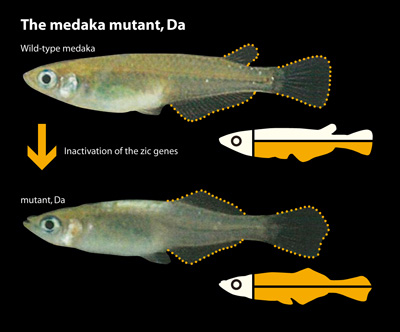
The medaka mutant, Da. In the Da mutation, the dorsal side of the body possesses the same characteristics as the ventral side, creating mirror-image symmetry. A mutation in the zic genes is responsible for this phenotype.
Takeda: Exactly. I initially started using medaka fish because their genetic background was so well understood, and it was only afterwards that I came to realize the historical links between the Japanese people and medaka fish. The fact that medaka fish have been used as model animals in various research processes throughout the postwar period in Japan has also proven very useful in current research. Today's research has been made possible through the accomplishments of past research.
Interviewer: Medaka fish are model animals that make you feel the richness and value of "time" aren't they?
Takeda: It is from among these medaka fish that a mutant fish with a double anal fin (Da) mutation was discovered, and that is the focus of my research. It was in the 1960s that a medaka was caught by chance in a rice paddy, that had a "double anal fin," or as its name suggests the dorsal fin was the same shape as the anal fin. Usually the medaka fish swim close to the surface of the water, eating insects that have fallen in to the water. To match this lifestyle, the body of the fish features a flat and black dorsal side, with a white rounded belly. However, fish with the Da mutation have gold-colored pigment on their backs and are more rounded all over. The original shape and color of the dorsal side has been entirely lost and has become more like the underside of the fish.
Interviewer: So the upper and lower parts of the fish are symmetrical?
Takeda: Yes. This symmetry is perhaps similar to tuna that swim in the middle layer of the water. After studying the causes for this mutation, it was found that the expression of only a single gene had changed, which is what caused the mutation. We could therefore identify this gene as the gene that determines the dorsal side of the fish.
Interviewer: A gene that determines the shape of the dorsal side of a fish! It's amazing that there is a gene dedicated to something like that!
Takeda: Given that initial generation process occurs for only an extremely short time, the gene that determines the shape of the dorsal side that switches on in that initial process then continues to express the same information forever, in order to maintain the shape of the dorsal side. This is probably something that is not limited to medaka fish, and similar genetic expressions could occur in many other animals, including humans. Although adults and children have slightly different proportions, we are all basically a similar shape, with the same shaped backs. This is because the gene that determines the shape of our backs continues to express the same information throughout our lives.
Interviewer: The cells in our bodies are all replaced every few years, aren't they? Would it be the case that if the genes that determine the shape of our backs in the newly created cells did not switch "on" our backs would no longer look like our backs usually do?
Takeda: Yes, and it is not simply a case of replacement; you have to bear in mind that the number of cells also increases. As we grow from childhood to adulthood our bodies grow larger, but our basic shape doesn't change. That is because just like the gene that determines the shape of our backs, there are other genes that continue the process of generation forever once they are switched on. To study this entire process in humans would take a great deal of time, but as medaka fish reach adulthood in just three months we can see clearly the processes involved.
Interviewer: If this research could be applied to humans I can see that it would be useful in basic medicine.
Takeda: As the principles of the generation process are also the same for creating the human body, research into this process could be useful, yes. Short-term gene expressions and longer-term expressions are both required in the human body. The process of generation is one that has many possibilities as evolution continues and it was by catching a medaka fish swimming in a paddy field and noticing that it was different from the others that led to this chance encounter with gene expressions. It was thanks to the fact that the medaka is a fish with such strong ties to the people of Japan that we happened to come across this mutation.
Continuing the naturalist spirit of Professor Morse
Interviewer: If we trace back the genealogy of your laboratory right back to the inception of the study of zoology at the University of Tokyo, we arrive at the first professor of zoology, Professor Edward S. Morse, an American zoologist and naturalist who worked for two years during the early period of the university and who also discovered the Jomon era shell mound at Omori in Tokyo.
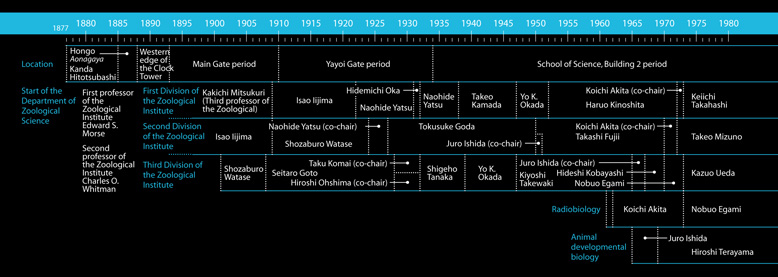
Changes in professors presiding over the Department of Zoological Science.
Takeda: Yes, that is true. Please take a look at this chronological chart (see diagram). Professor Morse was working at the university from the time the study of zoology started in 1877. In 1893 the zoological institute was split into first and second divisions, and then further expanded subsequently. If you look at the final name on the chronology for the second division of the institute, you will find Professor Takeo Mizuno, who was my supervisor. Originally Professor Morse came to Japan to collect various species of animal, as part of his work as a naturalist. He then created the basis of the Misaki Marine Station (currently the Misaki Marine Biological Station (MMBS), Graduate School of Science; originally located close to Enoshima). This marks the beginning of natural history study in Japan. It is for this reason that the study of biology at Todai is founded in the study of natural history. Research still focuses on "diversity of living things" and "the form of living things." Of course modern research now includes genetics, genome science and molecular biology, but these new areas have been fused with the original focus on natural history and have developed to become the zoological sciences as we know them today at Todai.
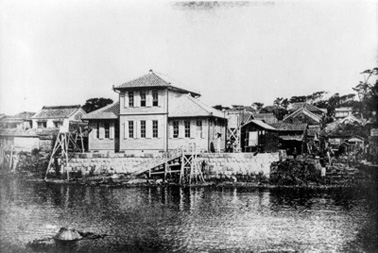
The Marine Station when it was located in Misaki-cho (circa 1886). © The Graduate School of Science, The University of Tokyo.
Interviewer: A naturalist spirit that has been continuously passed down over the years. The atmosphere of a laboratory that has gained so much from generation after generation of work reflects a sense of maturity that only the passage of "time" can provide, doesn't it?
Takeda: There is actually a little more to the story of Professor Morse. Last year in October a descendant of Professor Morse came to visit. Dr. Patricia Morse is engaged in research at the University of Washington and is currently a professor emeritus. After her visit she invited us to her home, situated on an island (San Juan Island, WA) in the United States. Her home was by the sea, in a location where you could see whales swimming.
Interviewer: What a wonderful anecdote. It shows the exchange between researchers that transcends time.
Takeda: These mutual visits provided the stimulus to commemorate the ties between the Morse family and Todai, and this year the E. S. Morse Institute was established. Through the new institute a variety of exchange programs between the Friday Harbor Labs of the University of Washington and the MMBS of Todai have now begun.
The conviction to leave results behind for the future
Interviewer: Today you have spoken about the daily flow of "time" through a laboratory, and the longer "time" through which knowledge is passed down within the walls of such a laboratory. You have also mentioned the various "time" scales, both long and short, which exist in the study of biology and embryology. To wrap up our interview today, could I ask for your thoughts about the timescale of "science" itself, in its widest sense?
Takeda: I believe that science is a system. Various researchers are all engaged in their own areas of study and they leave the results of their work in the form of papers, so that it can be reproduced. The accumulation of such research results constitutes the basic knowledge of science and as such science grows it becomes a kind of system. We learn about the systems that have grown from the accumulated knowledge of past researchers and add our own results to this body of knowledge. I believe that all researchers possess a sense of security, which is close to a conviction, that they are working within a system. If they produce work of high originality they will be sure to leave the results behind as a part of the system, and eventually someone else will come along to nurture new buds of research and build on the system that has been built up over long years. It is my wish to do exactly that and create new research findings that can be left behind to future researchers. I believe that whether it is ten years' time or a 100 years' time, someone will eventually come along to take the findings I have achieved a step further. In this way I believe that basic science is of use to society.
Interviewer: It is a fine concept to seek to leave findings behind for future researchers. I get the feeling that the timescale of science is truly epic.
Takeda: It is often said that the Nobel Prize is not granted for one discovery alone, but for the entire body of work and results that a community of researchers have built up over time on a given theme. Within an epic timescale pieces of "human wisdom" are created one by one and accumulate in a system. That is what I believe it means to be engaged in science.
February 25, 2013
In Professor Takeda's laboratory
School of Science, Building 2
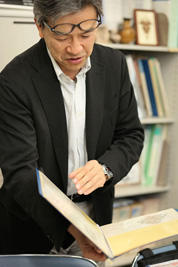
Professor Hiroyuki Takeda
Born in 1958. Graduated with a degree in zoological science from the Zoological Institute, the Faculty of Science of the University of Tokyo in 1982, subsequently gaining his Ph.D. In 1985 he was appointed assistant professor at the Faculty of Science of the University of Tokyo. In 1990 he started working as a research associate at RIKEN, in 1993 moving to Nagoya University to take up an assistant professorship. In 1999, he was appointed professor at the National Institute of Genetics. Since 2001 he has served as professor in the Graduate School of Science at the University of Tokyo.



